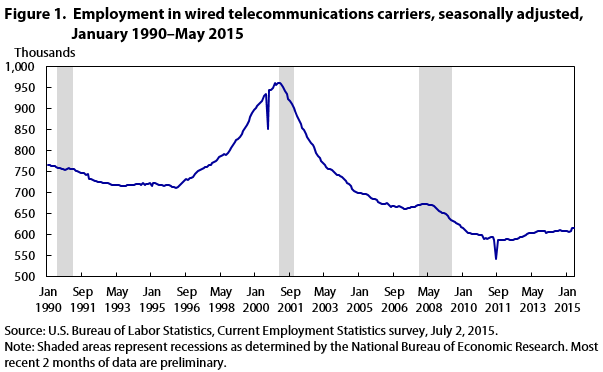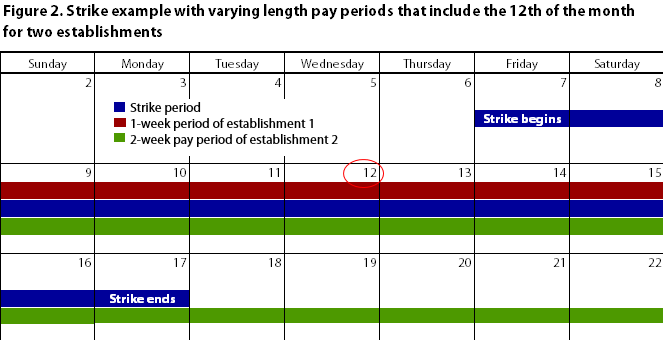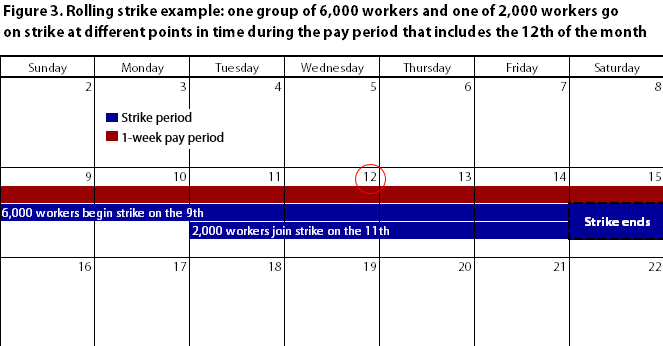An official website of the United States government
 United States Department of Labor
United States Department of Labor

Crossref 0
Employment continues to expand in 2023, though at a slower pace than in the previous 2 years, Monthly Labor Review, 2024.
Current Employment Statistics survey: 100 years of employment, hours, and earnings, Monthly Labor Review, 2016.
Total nonfarm employment recovers in 2022, with some major industry sectors lagging behind, Monthly Labor Review, 2023.
This article describes the various effects that strikes can have on Current Employment Statistics (CES) estimates. It discusses the challenges and limitations that CES faces in precisely quantifying these strike effects and why data users should understand these challenges and limitations when interpreting CES estimates.
Employment estimates from the Current Employment Statistics (CES) survey are among the first current economic indicators released by the federal government each month.1 The roots of the CES survey go back a century and began with the publication of employment data for four manufacturing industries in 1915. Since then, the survey has grown to cover over 900 industries and include approximately 52,000 employment, hours, and earnings data series. The survey is designed to capture many influences on employment, including cyclical and trend growth, changing seasonal patterns, weather, and strikes. Throughout the history of the CES program, strikes have affected employment estimates, sometimes significantly. For example, two of the largest strikes in CES history caused large changes in wired telecommunications employment in August 2000 and in August 2011.2 (See figure 1.) To accurately interpret employment in CES estimates, users of the data should understand how CES accounts for strikes. Users also should understand why CES cannot precisely quantify the impact of strikes on CES data.

| Year | January | February | March | April | May | June | July | August | September | October | November | December |
|---|---|---|---|---|---|---|---|---|---|---|---|---|
| 1990 | 765.0 | 764.7 | 762.0 | 761.9 | 762.2 | 760.8 | 759.1(1) | 757.8(1) | 755.6(1) | 755.1(1) | 752.5(1) | 756.4(1) |
| 1991 | 757.1(1) | 755.5(1) | 755.3(1) | 755.2 | 751.7 | 750.3 | 749.4 | 746.6 | 746.3 | 746.9 | 740.2 | 744.0 |
| 1992 | 731.0 | 732.0 | 730.2 | 727.2 | 726.3 | 725.2 | 724.5 | 723.8 | 723.2 | 722.4 | 721.7 | 722.7 |
| 1993 | 719.0 | 717.4 | 717.4 | 717.3 | 716.5 | 716.4 | 714.7 | 715.1 | 715.0 | 715.6 | 716.4 | 717.4 |
| 1994 | 717.3 | 718.5 | 718.4 | 719.0 | 720.2 | 718.8 | 718.6 | 721.5 | 718.1 | 719.1 | 719.5 | 721.6 |
| 1995 | 714.1 | 722.3 | 721.7 | 719.6 | 717.5 | 716.9 | 717.1 | 715.0 | 717.7 | 718.6 | 716.6 | 714.3 |
| 1996 | 713.1 | 711.9 | 711.1 | 712.3 | 715.0 | 720.4 | 724.7 | 729.0 | 732.0 | 729.7 | 733.8 | 734.7 |
| 1997 | 737.4 | 742.8 | 749.1 | 751.3 | 754.2 | 755.9 | 757.5 | 760.7 | 761.2 | 765.3 | 765.9 | 769.4 |
| 1998 | 772.8 | 775.1 | 777.7 | 783.8 | 785.9 | 789.4 | 791.9 | 788.9 | 793.4 | 801.3 | 806.1 | 812.6 |
| 1999 | 820.0 | 824.7 | 826.6 | 832.7 | 839.8 | 845.4 | 854.0 | 861.3 | 870.6 | 879.9 | 888.5 | 895.4 |
| 2000 | 900.1 | 905.0 | 911.1 | 915.4 | 917.9 | 928.6 | 934.0 | 851.8 | 943.0 | 944.6 | 948.2 | 960.5 |
| 2001 | 956.5 | 959.8 | 959.8(1) | 958.5(1) | 950.2(1) | 941.3(1) | 933.0(1) | 922.8(1) | 916.6(1) | 909.9(1) | 901.8(1) | 894.7 |
| 2002 | 880.8 | 871.0 | 863.0 | 853.4 | 847.6 | 840.0 | 831.6 | 825.0 | 816.8 | 813.5 | 808.4 | 793.7 |
| 2003 | 787.3 | 781.6 | 774.2 | 769.3 | 764.2 | 760.5 | 756.2 | 755.2 | 753.0 | 750.0 | 745.1 | 741.1 |
| 2004 | 741.3 | 739.8 | 736.0 | 731.2 | 725.9 | 723.0 | 720.0 | 715.9 | 708.7 | 702.5 | 700.5 | 699.4 |
| 2005 | 698.6 | 697.4 | 697.1 | 696.0 | 695.1 | 692.6 | 689.5 | 685.7 | 684.4 | 683.2 | 681.6 | 678.0 |
| 2006 | 673.7 | 672.8 | 672.2 | 673.2 | 675.2 | 669.4 | 665.9 | 666.9 | 667.3 | 665.2 | 665.3 | 666.4 |
| 2007 | 664.2 | 663.2 | 659.4 | 660.8 | 662.3 | 663.8 | 664.9 | 665.0 | 665.7 | 667.7 | 669.9 | 671.0(1) |
| 2008 | 672.4(1) | 671.5(1) | 671.3(1) | 671.2(1) | 670.8(1) | 669.3(1) | 669.2(1) | 667.3(1) | 663.8(1) | 659.6(1) | 654.8(1) | 652.4(1) |
| 2009 | 651.1(1) | 651.9(1) | 647.5(1) | 642.6(1) | 638.5(1) | 635.2(1) | 632.5 | 629.3 | 627.7 | 625.2 | 621.8 | 617.8 |
| 2010 | 615.1 | 610.8 | 606.8 | 604.3 | 602.2 | 601.9 | 599.9 | 600.8 | 599.8 | 598.5 | 598.5 | 597.5 |
| 2011 | 588.3 | 591.9 | 589.1 | 591.6 | 593.4 | 593.3 | 587.2 | 541.8 | 587.0 | 585.5 | 585.9 | 585.9 |
| 2012 | 587.1 | 588.0 | 587.9 | 587.5 | 586.0 | 585.5 | 588.9 | 590.1 | 590.5 | 593.6 | 593.8 | 595.5 |
| 2013 | 599.2 | 601.4 | 603.1 | 603.7 | 603.9 | 603.8 | 606.1 | 608.4 | 606.9 | 607.0 | 608.5 | 608.9 |
| 2014 | 604.2 | 604.8 | 605.0 | 605.8 | 606.3 | 607.6 | 607.3 | 607.7 | 610.8 | 608.9 | 607.7 | 607.5 |
| 2015 | 607.1 | 606.8 | 608.2 | 614.7 | 614.0 | 607.4 | 609.9 | 609.9 | — | — | — | — |
| Notes: (1) Economic recession, as designated by the National Bureau of Economic Research. Source: U.S. Bureau of Labor Statistics, Current Employment Statistics survey, July 2, 2015. | ||||||||||||
CES prepares a monthly summary of strike activity during the survey reference pay period, which is the pay period that includes the 12th of month. This pay period is specific to each establishment; it may be 1 week or 2 weeks long, or it may be monthly or semimonthly. The CES strike report contains information about workers directly involved in large strikes (1,000 or more workers) who were idle during the entire reference pay period.3 CES gathers information from public sources—such as media reports or publicly available company or union information—and the report itself is prepared and is then released on the U.S. Bureau of Labor Statistics (BLS, the Bureau) website before estimates are compiled. The numbers in the report indicate the possible direct effects of strikes on CES employment estimates for the current month. Thus, the strike report may be useful to people anticipating the upcoming payroll survey data. Also, after the monthly CES estimates are released, analysts attempting to discern underlying economic trends can use the strike report to exclude movements possibly caused by strikes.
The strike report includes information on the number of workers on strike during the current and previous reference periods, new strikes, strikes settled, and the net change. Information is provided on specific strikes and the industries they affect.4
In addition to the strike report, the BLS Work Stoppages program produces a broader measure of strike activity. This program provides monthly and annual data and analysis of work stoppages involving 1,000 workers or more. Like the CES Strike Report data, these data come from public sources. However, a key difference between the two is that work stoppages include all stoppages lasting a full shift or longer, while the CES Strike Report only includes strikes lasting the entirety of the survey reference pay period.5
Neither product, however, allows users to accurately quantify the effects of a strike on CES estimates. Users face many challenges in attempting to measure precise strike effects; the purpose of this article is to detail and explain these challenges.
The CES survey is focused on measuring month-to-month changes in employment, hours, and earnings at nonfarm business establishments. To accomplish this, CES collects payroll data each month from a subset—or sample—of all business establishments. CES asks survey respondents to submit a count of the total number of employees on their establishment’s payroll. This count includes anyone who worked or received pay during the CES survey reference period, which is the pay period—specific to each establishment—that includes the 12th of the month. Thus, people on strike for the entire period are not counted as employed, because they are not on the payroll.
The over-the-month change in employment can be affected by the net change in the number of strikers—the number of people newly on strike minus the number who returned to work after a settlement. Barring all other effects, if the net over-the-month change in the number of workers on strike is positive (more new strikers than returning workers), then the over-the-month change in employment is reduced. Conversely, if the net change in the number of workers on strike is negative, then the over-the-month change in employment is boosted. Those who were on strike during the prior month and continue on strike during the current month do not affect the over-the-month change in employment.
In evaluating a strike in CES estimates, CES considers these questions:
· Did the strike occupy all, part, or none of the CES survey reference period?
· Which industry or industries were affected by the strike?
· Is the strike captured by the CES sample?
· Were replacement workers hired?
Reference pay period. The timing of a strike is the most critical factor in determining whether it will be reflected in CES estimates. The CES reference period is the pay period that includes the 12th of the month. However, the starting and ending dates of pay periods, along with their length, vary among establishments. Because people paid for any part of the reference period are counted as employed, workers must be on strike for their entire pay period that includes the 12th day of the month to be excluded from CES employment counts. For example, in establishments with biweekly pay periods, workers must be out the full 2 weeks that include the 12th of the month; in establishments with semimonthly pay periods, they must be out the entire half of the month including the 12th of the month; and in establishments with monthly pay periods, workers must be out the entire month.

Consider the examples in figure 2. In each example, the blue-shaded area indicates the strike period, which runs from the 7th to the 17th of the month. The red-shaded area indicates the pay periods specific to establishment 1, and the green-shaded area indicates the pay period specific to establishment 2. Both pay periods include the 12th of the month, which is circled.
Establishment 1 has a 1-week Sunday-to-Saturday pay period that runs from the 9th to the 15th. This establishment’s workers were on strike for the entire pay period including the 12th. They, therefore, are not considered employed and are excluded from CES employment estimates.
Establishment 2 has a 2-week pay period, which runs from the 9th to the 22nd. In this case, workers were on the payroll after the strike ended. Because they were not on strike for the entire pay period including the 12th of the month, they are considered employed and, therefore, are included in CES employment estimates.

Rolling strikes can complicate determining if a strike should be included in CES estimates or not and can affect the magnitude of the strike effect. A rolling strike occurs when different groups of workers go on strike at different points in time. For example, figure 3 shows a strike of 6,000 workers that begins on the 9th and ends on the 15th of the month. On the 11th, however, 2,000 additional workers joined the strike, increasing the total number of striking workers to 8,000. However, because these additional strikers worked for part of the establishment pay period including the 12th of the month they are, according to CES definitions, considered employed. Therefore, only the initial 6,000 workers are excluded from CES employment estimates.
Industry. Industry classification is based on the North American Industry Classification System (NAICS) 2012.6 A company with numerous establishments, or worksites, may be classified into many industries. For example, an aerospace company that produces navigation equipment for airplanes might be classified into the manufacturing industry “search, detection, and navigation instruments” (CES NAICS-based industry code 31-334511). The same company may also have an establishment that designs computer systems used in aircraft communications, which would be classified in “custom computer programming services” (CES NAICS-based industry code 60-541511), a professional and business services industry. In this way, strikes against a single company can be distributed across several industries, affecting employment in each.
Many strikes are called by unions, which represent occupational groups, classes, or tradespeople. For example, an electrical workers’ union may go on strike against several companies scattered across many industries. This situation complicates evaluating exactly how many workers are striking within each individual industry.
Presence in the sample. The CES program is an establishment-based sample survey. Some companies are completely represented in the sample, while others are only partially represented or not represented at all. An example of complete representation is a company with 10 plants on strike, all of which are in the current CES sample at the time the estimate is made. An example of partial representation is a company with 10 plants on strike, but only 5 in the current CES sample. No representation is indicated by a company with 10 plants on strike, not one of which is present in the sample. Strikes are most easily accounted for if the striking establishments are completely represented in the CES sample. CES procedures ensure, however, that a strike is reflected in the CES estimates, regardless of its presence in the sample. Estimates often will have to be adjusted based on the extent of the representation of the striking company in the sample.
If a particular strike is only partially or not at all represented in the sample, CES will adjust the final estimate to reflect all people in the strike. In this case, the number of workers on strike usually is determined by contacting the strike-affected company or by using a published figure that is consistent across a variety of reputable public sources. This example is also the case for replacement workers; CES must adjust for known replacement workers at establishments that are not represented in the sample.
In addition to the number of strikers, the pay-period timing of nonsample units is another valuable piece of missing information when a strike is partially in the CES sample or not in the sample at all. Because the timing of the pay period is an important determinant of whether and how a strike is included in estimates, CES attempts to get pay-period information for affected companies. The first and best method for obtaining this information is to call the human resources staff of striking companies. If they are unable to provide the necessary information, unions sometimes can provide it. Along with these methods, extensive research is undertaken using news and other media sources.
Replacement workers. Sometimes the management of establishments with striking workers hires new workers to do the jobs of the strikers. The hiring of replacement workers can make assessing a strike’s impact on employment difficult. If replacement workers are hired during the same pay period in which a strike started, CES estimates may actually show employment growth because both the employees who will later go on strike and the replacement workers are counted as employed. If replacement workers are hired immediately upon the start of a strike, then the strike may not appear to be reflected in CES estimates. Furthermore, if replacement workers are hired later during an ongoing strike, their presence may falsely indicate that the strike is over. To further complicate matters, replacement workers could permanently displace striking workers or they could instead be just a temporary solution and be laid off when the strike ends. In dealing with the issue of replacement workers, usually users cannot draw conclusions directly from CES data. Instead, users must rely on public reports, company news, and other sources for such information. The Bureau’s pledge of confidentiality to its respondents precludes revealing any company-specific information.
In addition to direct effects on establishments whose workers are on strike, other establishments may experience secondary strike effects. One of the potential secondary effects of a strike involves establishments that are not on strike but depend on the striking establishment. Companies that are supplied by or are suppliers for a company whose workers are on strike may be affected. For example, a motor vehicle manufacturer may have to lay off workers or cut their hours if companies that supply their parts experience a prolonged strike.
Another secondary strike effect occurs when competitors of a striking firm add employees to cover additional business foregone by the striking company. For example, a strike at one airline may lead to increased business for their competitors. In extreme cases, this effect may even offset the magnitude of the strike’s primary effect on CES data.
Besides affecting CES employment counts, strikes can also affect estimates of workers’ average weekly hours and average hourly earnings. These are hours for which workers either are paid for work or are on paid leave (which includes vacation, holidays, sick leave, or other leave) for the pay period that includes the 12th of the month.
When strikers work part, but not all, of the reference pay period, the CES survey counts them as employed, but with reduced hours. The magnitude of the reduction on average weekly hours depends on the proportion of workers in the industry’s sample with reduced hours and the number of hours they worked.
When workers are on strike for an entire pay period, CES hours and earnings estimates can be affected by both within-industry effects and by sum-across-industries effects.
Within-industry effects. For the specific industry involved in the strike, estimates are affected only if the hours or earnings of the people on strike or layoff differ considerably from the industry’s average hours or earnings. The impact is phased in slowly over the months the strike continues. Because of confidentiality requirements, CES cannot provide information on the precise impact of a particular strike and related shutdowns on average weekly hours or average hourly earnings for a particular industry. However, the change in the industry estimate will include the impact of the strike, as well as developments that other sample members report.
Sum-across-industry effects. The absence of people on strike from payrolls may affect average weekly hours or average hourly earnings at higher levels of industry aggregation. If workers in the specific industry involved in the strike usually work shorter hours or earn less than workers in other industries in the aggregation, the hours and earnings estimates for the aggregation will be higher. Conversely, if workers in the specific industry involved in the strike usually work longer hours or earn more than workers in other industries in the aggregation, the hours and earnings estimates for the aggregation will be lower.
Data users’ understanding of the treatment of strikes in the CES employment estimates is necessary for a complete analysis of the data. Strikes should be identified and accurately reflected in the CES estimates for a variety of reasons. Depending on its timing compared with the survey reference pay period, a strike can affect data on employment, average weekly hours, and average hourly earnings in various ways. In addition, one should note that the precision with which strike effects can be measured is limited. Limited information, adherence to the strict CES definition of what is or is not included as employed, and secondary effects limit the CES program’s capability to exactly quantify the effects of strikes on CES employment, hours, and earnings.
John P. Mullins, "Understanding strikes in CES estimates," Monthly Labor Review, U.S. Bureau of Labor Statistics, November 2015, https://doi.org/10.21916/mlr.2015.43
1 The Current Employment Statistics (CES) program, which provides detailed industry data on employment, hours, and earnings of workers on nonfarm payrolls, is a monthly survey of about 143,000 businesses and government agencies, representing approximately 588,000 individual worksites. For more information on the program’s concepts and methodology, see “Technical notes for the Current Employment Statistics survey,” https://www.bls.gov/web/empsit/cestn.htm. To access CES data, see “Current Employment Statistics—CES (national),” https://www.bls.gov/ces/ . The CES data used in this article are seasonally adjusted unless otherwise noted.
2 For a listing of historical strikes of more than 1,000 workers occurring during the CES reference period, see https://www.bls.gov/ces/publications/strike-history.htm.
3 For the current CES strike report, see https://www.bls.gov/ces/publications/strike-report.htm.
4 Although the numbers in the strike report are useful to analysts, the figures should be used with caution, because they are preliminary and possibly incomplete. The CES strives to ensure the accuracy and completeness of the strike report; however, because the report is based on secondary sources, CES cannot guarantee its accuracy or completeness.
5 For more information on BLS work stoppages, see https://www.bls.gov/wsp/.
6 CES industry codes can differ from NAICS codes since industries are sometimes combined, primarily because of sample inadequacy issues.